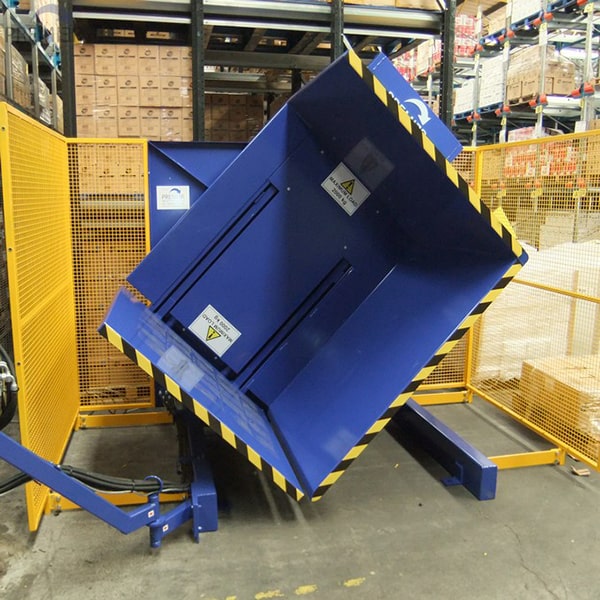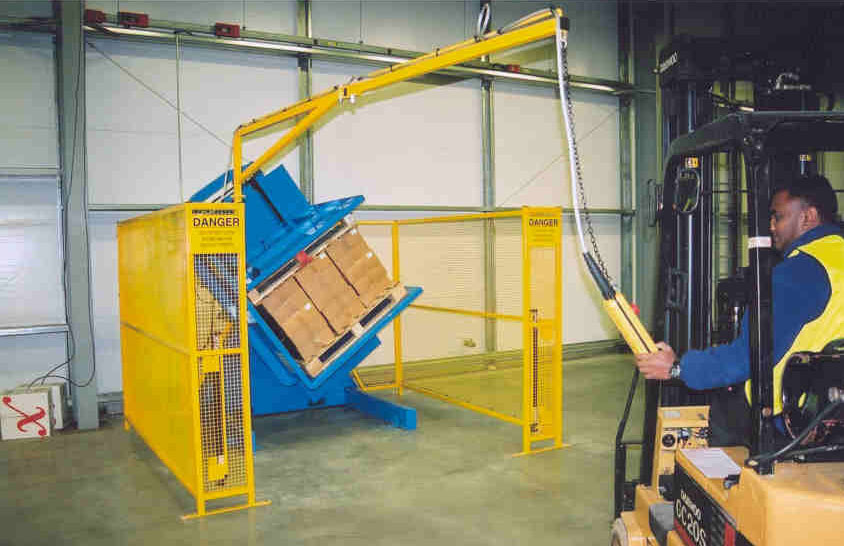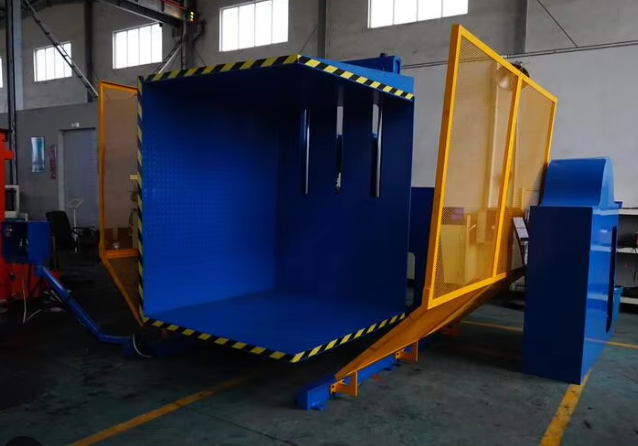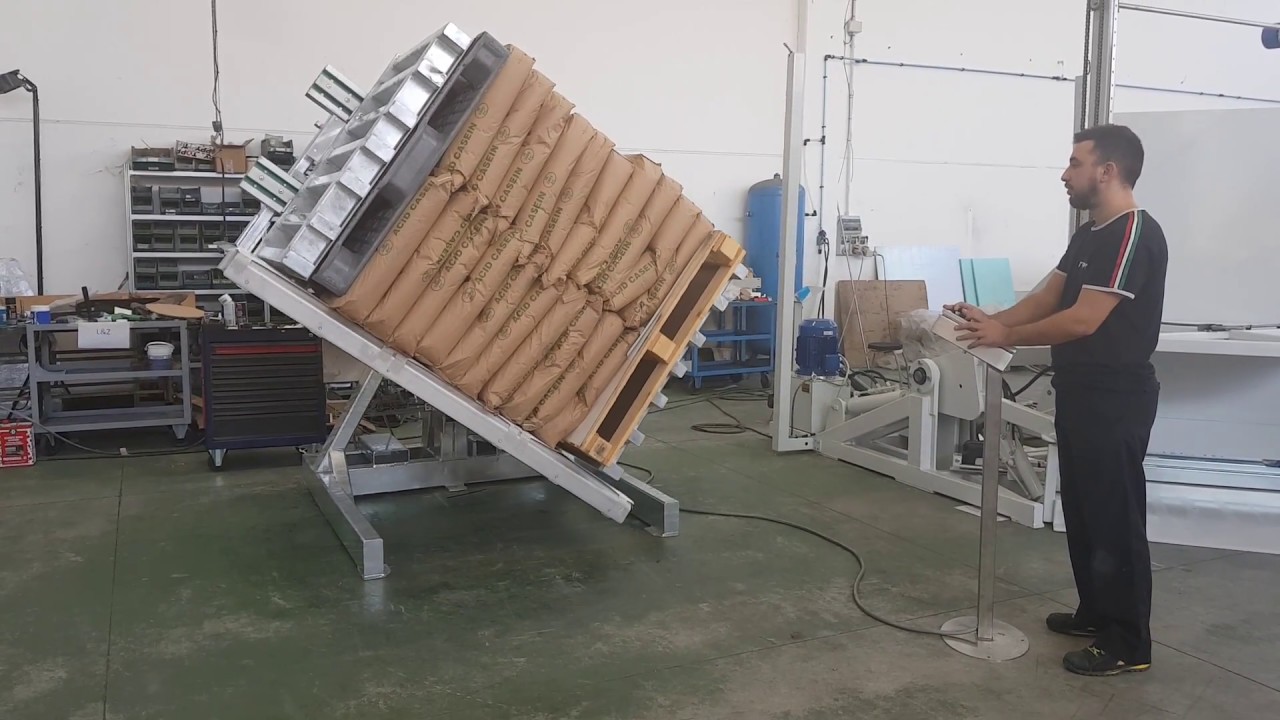Is Your Indonesia Factory Struggling with Worker Safety Amid Rising Logistics Demand? Try a Pallet Changing Machine
The logistics and manufacturing sectors in Indonesia are growing at an incredible pace. I see it every time I visit or speak with factory managers there. While this growth is exciting, it brings immense pressure. Production quotas are higher, deadlines are tighter, and the demand to move goods faster is relentless. This pressure often falls on the shoulders of your workers, leading to a sharp increase in manual handling tasks. With this comes the unavoidable risk of workplace accidents. Back injuries, muscle strains, and crushed limbs are not just possibilities; they are costly realities that can halt your production line.
Yes, if your factory in a rapidly growing market like Indonesia is facing worker safety challenges due to high logistics demand, a pallet changing machine is a direct and powerful solution. This equipment automates the transfer of goods from one pallet to another, completely removing the need for risky manual lifting and restacking. By doing this, you significantly cut down on the main causes of musculoskeletal injuries, boost your operational speed, and empower your team to meet rising demand without compromising their safety.

I understand the hesitation. As an engineer and a factory owner myself, every new piece of equipment needs to prove its worth. You're probably thinking, "Is this just another machine to maintain, or will it deliver real value?" I've been in your shoes, weighing the costs and benefits of every decision on the factory floor. That’s why I want to break down the practical, tangible ways a pallet changer can be a game-changer for your operation. This isn't just a theory; it's based on what I've seen and implemented in factories just like yours. Let's look at the real impact.
How Can a Pallet Changer Directly Improve Worker Safety?
You watch your team on the factory floor, and you see their commitment. But you also see the physical strain. Every time an employee has to bend over to manually unstack a pallet, lift a heavy box, and restack it onto a new pallet, there is a risk. You know that a single moment of fatigue or a simple misstep can lead to a serious injury.
This reliance on manual labor for such a repetitive and physically demanding task is a constant worry. The consequences of an accident are severe. You have an injured team member, production is disrupted, and you are left dealing with reports, potential fines, and a drop in team morale. The direct and indirect costs add up quickly. A pallet changer addresses this problem at its core. It automates the entire transfer process, transforming a high-risk manual job into a safe, controlled, and efficient automated task.
A pallet changer directly improves worker safety by taking over the dangerous job of manual load transfer. The machine uses a controlled mechanical process, like clamping and tilting, to move a full load of goods from one pallet to another. This design completely removes the need for manual lifting, bending, and restacking. These actions are the most common causes of back injuries, sprains, and other musculoskeletal disorders (MSDs) that plague logistics and manufacturing environments. By automating this single step, you remove one of the biggest safety hazards from your factory floor.

The Mechanics of Harm vs. The Mechanics of Help
Let's get into the details. When a person lifts a heavy object, especially from a low position, their spine and lower back muscles are put under immense pressure. Repetitive lifting, even with proper technique, causes cumulative damage over time. This leads to chronic pain, reduced mobility, and long-term disability. From my early days as an engineer on the floor, I saw firsthand how these injuries could end a person’s career. It’s a slow, grinding process that impacts your most experienced workers.
A pallet changing machine operates on simple, safe mechanical principles. For example, a pallet inverter clamps the load securely on the top and bottom. It then rotates the entire load 180 degrees. The original pallet is now on top and can be easily removed and replaced. The machine then rotates back, setting the goods down on the new pallet. The entire process takes about a minute and involves zero human lifting. The worker’s job changes from manual laborer to machine operator, a safer and more skilled role.
Here is a simple breakdown of the difference:
| Metric | Manual Pallet Changing | Automated Pallet Changing |
|---|---|---|
| Injury Risk | High (Back strain, sprains, crushed limbs) | Very Low (Operator is clear of moving parts) |
| Physical Strain | Constant bending, lifting, and twisting | Minimal; pushing buttons and operating controls |
| Worker Fatigue | High, leading to mistakes and slower work | Low, allowing for sustained focus and alertness |
| Task Nature | Repetitive, strenuous, low-skill | Supervisory, technical, higher-skill |
| Safety Culture | Reactive (Responding to accidents) | Proactive (Engineering out the risk) |
Beyond the Physical: Improving Team Morale
The benefits are not just physical. A safer work environment creates a more positive work culture. When your team sees that you are investing in their well-being, their morale and loyalty increase. They are no longer drained by physically punishing tasks. Instead, they can focus on quality control, machine operation, and other value-added activities. This shift reduces employee turnover and helps you retain skilled staff. I remember a project where we installed our first pallet inverter. The biggest change wasn't just the drop in injury reports; it was the atmosphere on the floor. The team was less stressed, more engaged, and took more pride in their work because they felt valued and protected.
What's the Real ROI of a Pallet Changing Machine in a High-Demand Environment?
Every investment you make comes under scrutiny. As a factory owner, I know you look at the price of a new machine and immediately weigh it against your budget and the constant pressure to lower costs. It is easy to view this kind of equipment as just another line item, another expense to be managed.
But what is the hidden cost of not making this investment? Think about the small, daily costs that add up over time. Slow cycle times during pallet exchange create bottlenecks. Goods get dropped or damaged during manual handling. And the financial impact of a single worker compensation claim can be huge, easily wiping out months of profit. These "invisible" expenses are quietly eroding your bottom line every single day. A pallet changing machine is not a cost center. It is an investment that provides a clear and fast return by directly attacking these hidden costs, delivering savings that often pay for the machine itself in a short time.
The real return on investment (ROI) for a pallet changing machine, especially in a high-demand environment, comes from a powerful mix of direct and indirect savings. It significantly cuts labor costs for manual handling, completely removes the high costs associated with workplace injuries, reduces product damage, and dramatically increases throughput. For many factories I've worked with, the combined savings allow the machine to pay for itself in 12 to 24 months.

A Practical Framework for Calculating Your Return
Let's move away from general statements and look at a practical way to calculate the payback for your specific situation. As an engineer, I believe in numbers. Javier, I know you do too. You don't need complex financial models to see the value here. A simple, back-of-the-envelope calculation can be very revealing.
1. Direct Cost Reductions:
- Labor Savings: This is the easiest to calculate. How many workers does it take to manually transfer a pallet load? How long does it take them? Let's say it takes two workers 20 minutes. A machine does it in 1 minute with one operator. You are saving significant labor time that can be reallocated to other productive tasks.
- Injury-Related Savings: This is a huge factor. A single serious back injury claim can cost tens of thousands of dollars in medical bills, lost work time, and insurance premium hikes. By eliminating the root cause of these injuries, you are avoiding a massive financial risk.
- Product Damage Savings: Manual handling is inconsistent. Products get dropped, boxes are crushed, and bags are torn. A machine handles every load with the same gentle, controlled motion, dramatically reducing damage and waste.
2. Efficiency and Revenue Gains:
- Increased Throughput: A machine can change a pallet in about 60 seconds. Manual teams can take 15-30 minutes. In a high-demand environment, this time difference is massive. You can process more goods per hour, which directly translates to higher output and revenue. It helps you meet the 95% capacity utilization goal you're aiming for.
Here is a sample ROI calculation to illustrate the point:
| ROI Component | Manual Method (Annual Cost) | Pallet Changer (Annual Impact) | Annual Savings |
|---|---|---|---|
| Labor | 2 Workers x 4 hrs/day x $5/hr x 250 days = $10,000 | 1 Operator x 1 hr/day x $6/hr x 250 days = $1,500 | $8,500 |
| Injury Risk | Avg. 1 minor injury/year = $2,000 | Risk eliminated = $0 | $2,000 |
| Product Damage | 1% of $500,000 handled goods = $5,000 | 0.1% of $500,000 handled goods = $500 | $4,500 |
| Throughput | Bottleneck limits output | Removes bottleneck, adds 5% capacity = $25,000 | $25,000 |
| Total Annual Value | $40,000 |
With an initial investment of, say, $30,000-$50,000, the payback period is clearly very short. This isn't just about saving money; it's about building a more resilient and profitable operation.
Are Pallet Changers a One-Size-Fits-All Solution?
Your factory is not like any other. You have a specific layout, you handle unique products, and your team follows workflows that have been developed over years. The thought of bringing in a standard, off-the-shelf machine can be worrying. You might be concerned that it won't fit your space or, worse, that it won't be able to handle your products safely and efficiently.
This fear is completely valid. Investing in a piece of equipment only to discover that it disrupts your process or damages your goods is a nightmare scenario for any factory manager. A generic solution that doesn't account for your specific needs can easily create more problems than it solves. But this is where the right approach makes all the difference. Pallet changers are not a one-size-fits-all product. A supplier who acts as a strategic partner will work with you to understand every detail of your operation and provide a machine that is perfectly tailored to your requirements.
No, pallet changers are definitely not a one-size-fits-all solution. They are available in many different designs, such as 180-degree inverters, 90-degree tippers, and floor-level pusher systems. Each type is engineered for different load characteristics, weights, fragility levels, and operational needs. The right choice depends entirely on your specific products—whether you handle sacks, boxes, drums, or fragile vials—as well as your facility layout and how much automation you want to integrate.

Matching the Machine to Your Mission
Choosing the right pallet changer is critical. This is where my team and I spend most of our time—not just selling machines, but engineering solutions. It starts with understanding your product and process.
1. Pallet Inverters (180° Rotation):
These are the workhorses for robust, stable loads. Think of bags of cement, canned goods, or blocks of steel. The machine clamps the load from the top and bottom, creating a secure box around it. It then rotates a full 180 degrees. The old pallet is now on top, ready to be swapped out. This method is fast and very secure for loads that are not sensitive to being inverted.
2. Pallet Exchangers (90° Tippers):
What if your products are more delicate? For example, open-top barrels, pails of paint, or fragile electronics. Inverting these loads is not an option. This is where a 90-degree tipper comes in. The machine gently tilts the load back 90 degrees, allowing the pallet to be removed from the bottom. The new pallet is put in place, and the machine gently tilts the load back down. It’s a smoother motion designed for load stability.
3. Pusher or Slider Systems:
These are often the best choice for integrating directly into an automated conveyor line. A pusher system doesn't lift or tilt the load at all. Instead, it holds the load stationary while pushing it horizontally from the old pallet onto a new pallet waiting right beside it. This is ideal for high-volume operations where speed and seamless integration are key.
Here is a simple guide to help you think about the options:
| Machine Type | Primary Mechanism | Best For | Key Advantage |
|---|---|---|---|
| Pallet Inverter | Clamps and rotates 180° | Stable, durable goods (sacks, cans, blocks) | Speed and security for robust loads |
| Pallet Exchanger | Tilts 90° and slides | Sensitive or unstable loads (bottles, pails) | Gentle handling, avoids inversion |
| Pusher System | Pushes load horizontally | Boxed goods, integration with conveyors | Seamless flow, no lifting required |
This is why we, at SHJLPACK, believe in a partnership approach. We don’t just show you a catalog. We ask for photos of your products, videos of your current process, and drawings of your floor plan. We want to understand your challenges completely. From there, we can recommend or even custom-design a machine with the right clamping pressure, guarding options, or footprint for your factory. This is the difference between buying a machine and investing in a total solution.
How Does Integrating a Pallet Changer Fit into a Broader Digitalization Strategy?
You are looking to the future. You are already implementing or planning to implement systems like MES (Manufacturing Execution System) and IoT sensors to create a truly "smart factory." Your goal is total visibility and control over your production processes. You want data, not just machines.
In this context, an isolated, standalone machine can be a major problem. It becomes a "black box" in your production line. It does its job, but it doesn't communicate. It provides no data, it can't be tracked by your central systems, and it stands in the way of your vision for a fully connected operation. This is a legitimate concern for any forward-thinking leader like Javier. But a modern pallet changer is not a dumb machine. It is designed to be a smart, communicative node within your factory's digital ecosystem.
Integrating a pallet changer fits perfectly into a digitalization strategy because it serves as an automated data-gathering point in your material flow. Modern pallet changers are built with PLCs (Programmable Logic Controllers) and can be equipped with a range of sensors and communication modules. These allow the machine to connect directly to your MES or WMS (Warehouse Management System). This integration enables real-time tracking of pallet movements, cycle times, machine status, and fault alerts, feeding valuable data directly into your analytics platforms.

Turning Mechanical Action into Actionable Intelligence
The true power of a smart factory comes from data. A modern pallet changer is designed to be a rich source of this data, helping you achieve the operational excellence and cost reductions you are targeting.
1. Data Points for Production Visibility:
The machine's PLC can track every action. A cycle counter tells you exactly how many pallets have been processed, which can be compared against your production schedule in the MES. Uptime and downtime sensors can tell you precisely how long the machine is running versus how long it is idle, which is a key component of Overall Equipment Effectiveness (OEE) calculations. This directly supports your goal of 95% capacity utilization.
2. Data for Predictive Maintenance:
Instead of waiting for a breakdown, you can use data to predict it. Sensors can monitor motor temperature, hydraulic pressure, or vibration levels. When these metrics start to drift outside of normal parameters, the system can send an alert to your maintenance team. This allows you to schedule repairs during planned downtime, rather than suffering a surprise failure that stops your entire line. This is a core part of moving from a reactive to a proactive operational model.
3. Integration for Full Automation:
A pallet changer doesn't have to be a standalone island. It can be the critical link in a fully automated logistics chain. Imagine this workflow: an Automated Guided Vehicle (AGV) brings a pallet of raw materials from the warehouse. It delivers it to the pallet changer, which swaps the supplier's wooden pallet for your factory's standard plastic pallet. The load is then picked up by another AGV and delivered to the production line, all without human intervention. This is not science fiction; it is what a fully integrated smart factory looks like.
| Data Point from Pallet Changer | How It's Used in Your MES/Digital Platform | Your Goal It Supports |
|---|---|---|
| Cycle Count & Time | Measures throughput, calculates OEE | Increase Capacity Utilization |
| Fault Codes & Alarms | Pinpoints issues for fast troubleshooting | Lower Operating Costs |
| Motor Current & Uptime | Triggers predictive maintenance alerts | Increase Capacity Utilization |
| Load Weight (optional sensor) | Verifies inventory, ensures load stability | Improve Quality & Safety |
I worked with a client in the steel parts industry who integrated one of our pallet changers with their MES. For years, they had an unexplained bottleneck between their stamping line and their packaging area. After integrating the machine, the data clearly showed that the manual pallet-swapping process was the cause. Automating that single point increased their end-of-line efficiency by over 15%. This is the power of turning a simple mechanical task into an intelligent, data-producing asset.
Conclusion
A pallet changer is more than a tool for safety or speed. It is a strategic investment in efficiency, data, and future-proofing your operations. Let's build a safer, smarter factory together.




